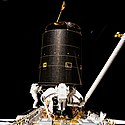Intelsat 603
 Astronauci misji STS-49 w trakcie operacji przechwytywania satelity Intelsat 603 na orbicie | |
| Inne nazwy | Intelsat 6 F-3, IS-603, 20523 |
|---|---|
| Indeks COSPAR | 1990-021A |
| Zaangażowani | |
| Model satelity | HS-389 |
| Rakieta nośna | Commercial Titan III (CT-2) |
| Miejsce startu | |
| Orbita (docelowa, początkowa) | |
| Okres obiegu | 1436 min |
| Czas trwania | |
| Początek misji | 14 marca 1990 11:52 UTC |
| Koniec misji | styczeń 2013 |
| Wymiary | |
| Masa całkowita | 4215 kg |
| Masa ładunku użytecznego | 2560 kg |
Intelsat 603 (ang. International Telecommunications Satellite) – satelita telekomunikacyjny należący do operatora Intelsat, międzynarodowego giganta w tej dziedzinie, który od 1965 roku wyniósł na orbitę przeszło 80 satelitów. Intelsat 603 został wyniesiony na orbitę 14 marca 1990 roku za pomocą rakiety Commercial Titan III, jednak nie opuścił niskiej orbity okołoziemskiej. Błąd ten naprawiła w maju 1992 roku załoga misji STS-49, w której użyto po raz pierwszy promu Endeavour. Astronauci przechwycili satelitę i dołączyli do niego nowy silnik rakietowy, który umożliwił Intelsatowi 603 wejście na orbitę geostacjonarną.
Satelita pracował na orbicie geostacjonarnej (nad równikiem), początkowo na pozycji 34,5 stopnia długości geograficznej zachodniej, w latach 1997-2002 na 24,5°W, 2002-2010 na 19,95°W, 2010-2013 na 11,5°E[1]. W styczniu 2013 roku zakończył pracę[1].
Zobacz też
Przypisy
- ↑ a b Intelsat 603 (ang.). W: The Satellite Encyclopedia [on-line]. TBS Internet. [dostęp 2013-11-25].
Bibliografia
- Jonathan's Space Home Page (ang.)
- NSSDC Master Catalog (ang.)
- Space 40 (cz.)
Linki zewnętrzne
- Historyczny wykaz programów nadawanych przez satelitę Intelsat 603. flysat.com. [zarchiwizowane z tego adresu (2008-05-12)]. (ang.)
- Strona operatora Intelsat (ang.)
Media użyte na tej stronie
Three crewmembers of mission STS-49 hold onto the 4.5 ton International Telecommunications Organization Satellite (INTELSAT) VI after a six-handed "capture" was made minutes earlier during the mission's third extravehicular activity (EVA).
From left to right: Mission Specialists(MS) Richard J. Hieb, Thomas D. Akers, and Pierre J. Thuot.
The three prepare to attach the capture bar which is tethered to Hieb. Thuot is positioned on the Remote Manipulator System (RMS) arm, from which he had made two earlier unsuccessful grapple attempts on two-person EVA sessions. Ground controllers and crewmembers agreed that a third attempt, using three mission specialists in the payload bay (PLB) was the effort needed to accomplish the capture feat. It worked, and to date, this remains the only three-person EVA.
Behind the three astronauts is the vertical perigee stage which will be attached to the Intelsat VI prior to its release from the PLB.